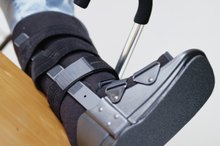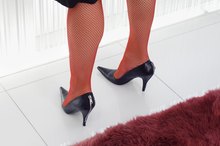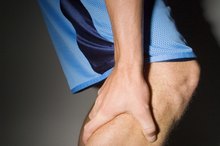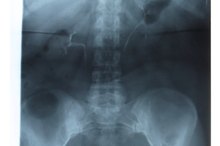Weight Bearing Immediately After Bunionectomy
A bunion is a deformity of the foot that occurs at the point where your big toe connects to your foot. A bump forms around the joint, which can become painful and impedes mobility. A bunionectomy is the term used to describe surgery that excises the bunion from your foot 12. Bunionectomy may also be referred to as an exostectomy. The time frame for weight bearing on your affected foot after a bunionectomy varies and is decided by your doctor based on your condition and the extent of your surgery 2.
If you are experiencing serious medical symptoms, seek emergency treatment immediately.
Limitations
Having straightforward bunion surgery--removing the bunion without the need for extensive repairing of the ligaments and joint of your big toe--increases the chances that you'll be able to begin partial weight-bearing on your foot soon after your procedure 1. A bunionectomy is an hour-long outpatient procedure in most cases. Most people who have a simple bunionectomy can go home within a couple hours post-surgery 2. You most likely will be in enough pain that you won't want to, and may be advised not to bear weight on your foot immediately, but over the course of the next few days, you can gradually bear partial weight. Limitations to early weightbearing include driving: you will not be able to drive for about a week after bunion surgery. If you've sustained more serious damage to your foot, you may require more time off your feet and will be advised of such by your doctor.
- Having straightforward bunion surgery--removing the bunion without the need for extensive repairing of the ligaments and joint of your big toe--increases the chances that you'll be able to begin partial weight-bearing on your foot soon after your procedure 1.
- You most likely will be in enough pain that you won't want to, and may be advised not to bear weight on your foot immediately, but over the course of the next few days, you can gradually bear partial weight.
Mobility Aids
Rehabilitation of a Fractured Heel Bone
Learn More
Walkers, crutches and canes are mobility aids that can help you get around immediately following bunion surgery. For the first day or so, you may need to use the crutches without bearing weight on your foot, but over the course of the first week, you should be able to progressively put more weight on your foot and use the crutches as a support only until you feel you no longer need them. Even if you can walk without the help of mobility aids within the first week after a bunionectomy, don't push yourself. According to NYU's Hospital for Joint Diseases, walking and standing too much in the early days can hamper recovery.
- Walkers, crutches and canes are mobility aids that can help you get around immediately following bunion surgery.
- Even if you can walk without the help of mobility aids within the first week after a bunionectomy, don't push yourself.
Footwear
Special shoes or boots that support your foot and help you feel more comfortable during weight bearing are usually prescribed by your doctor immediately after surgery. One type of post-operative boot is called a Darco shoe and accommodates the swelling you'll have post-bunionectomy. Within a month after your surgery, barring complications, you probably will be ready to wear regular shoes when walking. Sneakers or other sturdy, boxy-toed shoes are appropriate for bunion surgery patients because they are roomy. One of the main causes of bunions is wearing shoes that don't fit right or are too pointy and pinch your toes.
- Special shoes or boots that support your foot and help you feel more comfortable during weight bearing are usually prescribed by your doctor immediately after surgery.
- One type of post-operative boot is called a Darco shoe and accommodates the swelling you'll have post-bunionectomy.
Considerations
How to Recover from Hammertoe and Bunion Surgery
Learn More
A bunionectomy is a term that may be used broadly to describe bunion removal, when in reality there are more than 100 types of bunion surgery 2. Speak to your doctor about the type of surgery you'll be having before the operation, in order to have realistic expectations about your weight-bearing guidelines after surgery.
Related Articles
References
- Your Orthopaedic Connection: Bunion Surgery
- Encyclopedia of Surgery: Bunionectomy
- Shi GG, Humayun A, Whalen JL, Kitaoka HB. Management of Bunionette Deformity. J Am Acad Orthop Surg. 2018;26(19):e396-e404.
- InformedHealth.org [Internet]. Cologne, Germany: Institute for Quality and Efficiency in Health Care (IQWiG); 2006-. Bunions: Overview. 2018 Jun 28. Available from: https://www.ncbi.nlm.nih.gov/books/NBK513134/
- Ferrari J. Bunions. BMJ Clin Evid. 2009;2009:1112. Published 2009 Mar 11.
- Ellington JK. Hammertoes and clawtoes: proximal interphalangeal joint correction. Foot Ankle Clin. 2011;16(4):547-58.
- Al Aboud AM, Badri T. Corns. [Updated 2019 Oct 26]. In: StatPearls [Internet]. Treasure Island (FL): StatPearls Publishing; 2019 Jan-. Available from: https://www.ncbi.nlm.nih.gov/books/NBK470374/
- Tamer P, Simpson S. Evolutionarily medicine Why do humans get bunions? [published correction appears in Evol Med Public Health. 2017 May 09;2017(1):81]. Evol Med Public Health. 2017;2017(1):48–49. Published 2017 Feb 11. doi:10.1093/emph/eox001
- Chou LB. Disorders of the first metatarsophalangeal joint: diagnosis of great-toe pain. Phys Sportsmed. 2000;28(7):32-45.
- Kitson K. Bunions: their origin and treatment. J Perioper Pract. 2007;17(7):308-10, 315-6.
- Kalen V, Brecher A. Relationship between adolescent bunions and flatfeet. Foot Ankle. 1988;8(6):331-6.
- Shirley ED, Demaio M, Bodurtha J. Ehlers-danlos syndrome in orthopaedics: etiology, diagnosis, and treatment implications. Sports Health. 2012;4(5):394–403. doi:10.1177/1941738112452385
- Nork SE, Coughlin RR. How to examine a foot and what to do with a bunion. Prim Care. 1996;23(2):281-97.
- Ferrari J, Higgins JP, Prior TD. Interventions for treating hallux valgus (abductovalgus) and bunions. Cochrane Database Syst Rev. 2004;(1):CD000964.
- Hurn SE, Vicenzino BT, Smith MD. Non-surgical treatment of hallux valgus: a current practice survey of Australian podiatrists. J Foot Ankle Res. 2016;9:16. Published 2016 May 4. doi:10.1186/s13047-016-0146-5
- Grice J, Marsland D, Smith G, Calder J. Efficacy of Foot and Ankle Corticosteroid Injections. Foot Ankle Int. 2017;38(1):8-13.
- Tehraninasr A, Saeedi H, Forogh B, Bahramizadeh M, Keyhani MR. Effects of insole with toe-separator and night splint on patients with painful hallux valgus: a comparative study. Prosthet Orthot Int. 2008;32(1):79-83.
- Branthwaite H, Chockalingam N, Greenhalgh A. The effect of shoe toe box shape and volume on forefoot interdigital and plantar pressures in healthy females. J Foot Ankle Res. 2013;6:28. Published 2013 Jul 25. doi:10.1186/1757-1146-6-28
- Boulton AJ, Armstrong DG, Albert SF, et al. Comprehensive foot examination and risk assessment: a report of the task force of the foot care interest group of the American Diabetes Association, with endorsement by the American Association of Clinical Endocrinologists. Diabetes Care. 2008;31(8):1679–1685. doi:10.2337/dc08-9021
- Menz HB. Foot orthoses: how much customisation is necessary?. J Foot Ankle Res. 2009;2:23. Published 2009 Jul 9. doi:10.1186/1757-1146-2-23
- Mortka K, Lisiński P. Hallux valgus-a case for a physiotherapist or only for a surgeon? Literature review. J Phys Ther Sci. 2015;27(10):3303–3307. doi:10.1589/jpts.27.3303
- Meyr AJ, Singh S, Chen O, Ali S. A pictorial review of reconstructive foot and ankle surgery: hallux abductovalgus. J Radiol Case Rep. 2015;9(6):29–43. Published 2015 Jun 30. doi:10.3941/jrcr.v9i6.2142
- American Podiatric Medical Association. (2019). Bunions. https://www.apma.org/Patients/FootHealth.cfm?ItemNumber=979
- Dini M. Podiatric Disorders. In: Papadakis MA, McPhee SJ, Rabow MW. eds. Current Medical Diagnosis & Treatment 2019 New York, NY: McGraw-Hill; http://accessmedicine.mhmedical.com/content.aspx?bookid=2449§ionid=194443900.
- Ferrari J (2017). Hallux valgus deformity (bunion). Eiff P, Asplund CA, eds. UpToDate. Waltham, MA: UpToDate Inc.
- Hern, S.; Vicenzino, B.; and Smith, M. Non-surgical treatment of hallux valgus: a current practice survey of Australian podiatrists. J Foot Ankle Res. 2016;9:16. DOI: 10.1186/s13047-016-0146-5.
- MacDonald, A.; Houck, J.; and Baumhauer, J. The Road to Recovery for Bunion Surgery. Foot Ankle Orthoped. 2017. DOI: 10.1177/2473011417S000275.
Writer Bio
Erica Roth has been a writer since 2007. She is a member of the Society of Professional Journalists and was a college reference librarian for eight years. Roth earned a Bachelor of Arts in French literature from Brandeis University and Master of Library Science from Simmons College Graduate School of Library and Information Science. Her articles appear on various websites.








